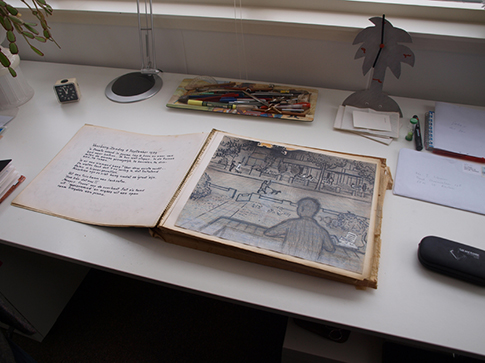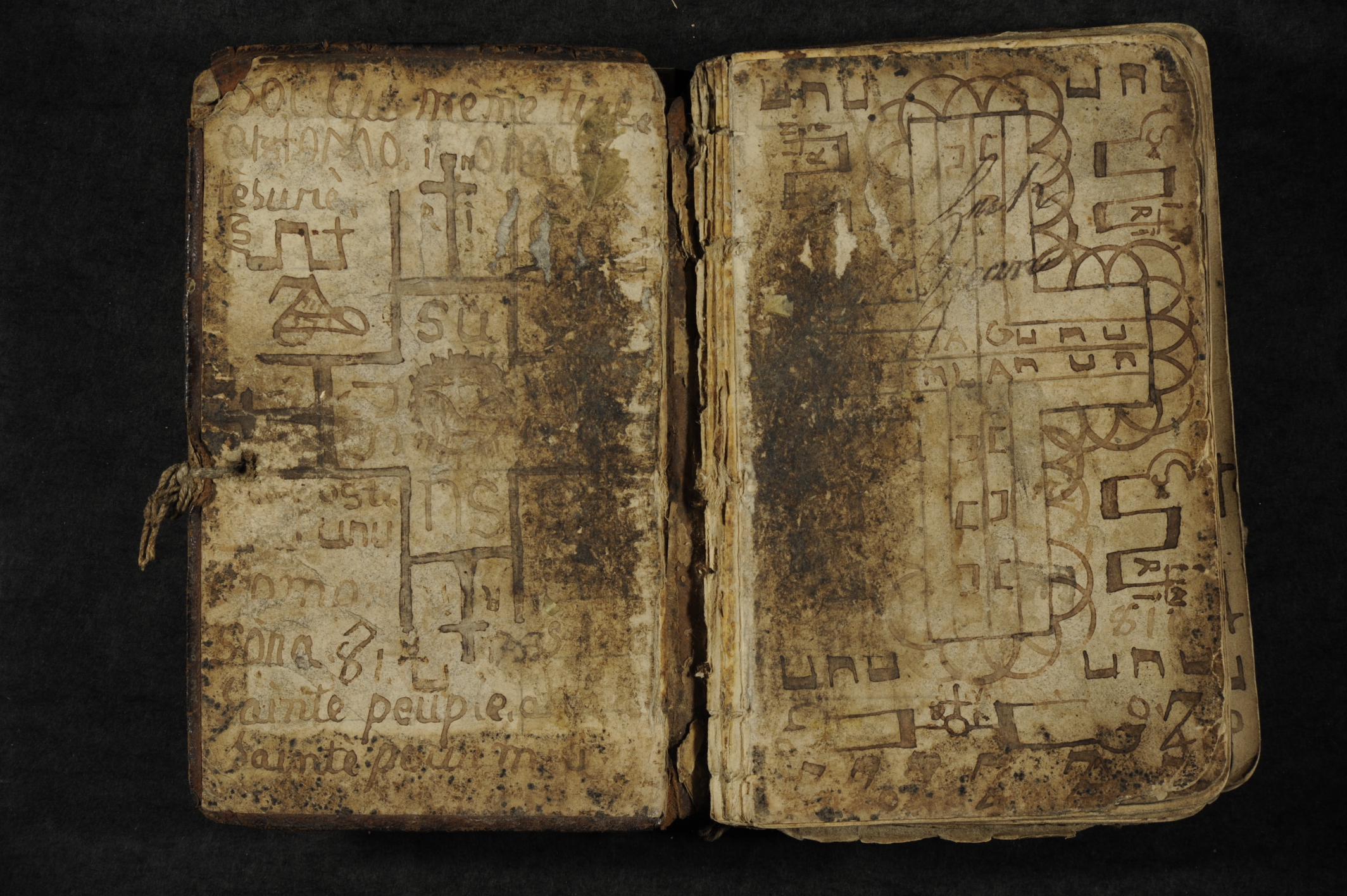Theo de Feyter]
[September 7, 2014
Jan Vegter´s art of processing memory. A biographical sketch.
Nicht übersetzt:
Jan Vegter was born March 29, 1927, in Voorburg (The Netherlands). He died there in 2009. Almost his entire life he lived in this small town near The Hague. Jan got his education as an artist at the Royal Academy at The Hague from 1945 till 1950. One of his teachers was Willem Rozendaal (1899 – 1971), graphic artist and designer. Jan is the older brother of Jaap Vegter, well-known illustrator and graphic designer.
In the final year his father took him from the academy to work as an apprentice in the family wholesale business in men’s wear and haberdashery. ‘You will have no future as an artist,’ he told Jan, ‘It is better to learn a more solid métier. ’ For ten years Jan worked in his father’s business, initially as a salesman, later as a clerk in the office. During this whole period he lived with his parents in Voorburg.
In 1960, being very dissatisfied with his work, Jan decided to quit his job and live as an artist. He moved to The Hague, rented a small studio and started to teach drawing at a local High School. He tried to obtain an official qualification as a teacher but failed all the exams. In the end he was granted dispensation on the ground of his academy education and experience as an artist and so he could teach without official license from now on until his retirement in 1992. Jan was active as a freelance artist as well and exhibited at Pulchri Studio in The Hague, a renowned artist’s society of which he was a member. After obtaining the dispensation in 1965 he married Joke Scheurer. The couple moved to Voorburg.
Jan Vegter’s work consists of drawings mainly. They are almost exclusively mixed media (a combination of ink, charcoal, tempera, pastel and color pencil) on paper and cardboard of rather grand dimensions. He uses panoramic sizes (45 x 90 cm or 60 x 110 cm) on a regular base. Very often the drawings are images from memory, or rather memory images: they are not mere recollections of occasional events, but ‘translations’ of the emotional impact a certain event had on him. They can be landscapes or village views he perceived during his trips as a salesman, it can be the interior of a French village church observed during Sunday Mass, it can be a self-portrait while walking in a snowy Rotterdam Zoo. These are just a few examples of subjects, or rather symbols one could almost say, deeply connected to his personal biography.
Jan Vegter, model of a Parisian citybus
The intense atmosphere of Jan Vegter´s drawings is the result of a striking sense of detail. Regularly they are suggestive of being meticulous building plans of memorized situations. It comes as no surprise that he made detailed scale models of train stations, railroad tracks, coaches and buses which he then used in his drawings. In his series of memory drawings of World War II there is always a special attention to be traced for means of transport, for stations, trains and tracks, and in general for the motorized materiel, in short for the technical side of war.
Jan Vegter, model of a railwaystation premises
Graphic series play an important role in his oeuvre. Jan´s intention is to tell stories, and obviously the serial format serves this inclination very well. After his retirement in 1992 he found the time to create these laborious series in which he could visualize long cherished memories of crucial periods in his life. They are in the same ‘dry’, almost technical style as all of his drawings, presenting his recollections as mere facts. The sizes of the drawings vary, but they never exceed the size of the enfolding sketchbooks: 32 x 41 cm. Sometimes they are realized on separate paper and pasted on one of the pages of the sketchbook. All drawings are in mixed media of ink and color pencil. Sometimes white tempera is used for high lights. The drawings are always on the right page. The left pages have handwritten texts, clarifying in dry comments what can be seen in the drawings.
Jan Vegter, “Meppel, een raar jaar”, plate 001, text and image
The first series is entitled ‘Meppel, een raar jaar’ (‘Meppel, an odd year’) and is divided into three sketchbooks with twenty-three, twenty-four and four drawings respectively. Shortly before the outbreak of World War II in September 1939 Jan’s father, being a reserve-officer, was mobilized and stationed in the small town of Meppel, in the east of The Netherlands. This was a precautionary measure as The Netherlands were a neutral power at the time. This only changed when the country was attacked by Germany on May 10, 1940. As an officer Vegter sr. could bring along his familiy.. In reality Jan’s ‘odd year’ in Meppel lasted only a half – year, from December 1939 until April 1940, when the threat of war increased in such a way that Jan’s father thought it was better to return his family to Voorburg. The series of drawings also covers the German invasion, the bombardment of Rotterdam and the first days of the occupation.
Jan Vegter, “Meppel, een raar jaar” (plate 001): Voorburg, Sunday September 3, 1939. A sultry evening. I walked to and fro from bed to balcony in pyjamas. I couldn’t sleep. In the gardens people sat and chatted pleasantly, drinking and smoking. / Isn’t anybody afraid? It is the first night! They know there is a war going on, don’t they? That Germany invaded Poland? / Maybe they are not afraid because they are ‘grown-ups’./ From a garden came a burst of laughter. / ‘How can that be?!’ / Mr. Couvé, from the opposite side of the street, walked his dog – ‘good evening’ – and somewhere from an open window a piano was tinkling away
Jan Vegter, “Meppel, een raar jaar” (plate 028): The flu..! A life like a prince! Wonderful!! / For the time being I didn’t have to get better.
Jan Vegter, “Meppel, een raar jaar” (plate 047): ‘Ja, mein Junge, Rotterdam. Schade!’
Jan Vegter, “Meppel, een raar jaar” (plate 051): It was June already when my father strolled through Voorburg again. / Back from the hospital! / Shrapnel in his hand./ And he was a lucky one!
The second series is entitled ‘Hongerwinter en bevrijding’ (‘Hunger winter and liberation’). It consists of eighteen drawings with accompanying texts, pasted on papers of 32 x 41 cm and kept in an envelop. By ‘Hunger winter’ the Dutch famine of 1944 is meant. The northern part of The Netherlands was among the last regions in Europe occupied by German forces and only liberated in May 1945. One of the drawings shows the consequences of the bombardment by the English of a residential area of The Hague. The area was mistakenly held for the nearby launching site of a V-2 rocket installation.
Jan Vegter, “Hongerwinter en bevrijding’” (plate 010): Saturday afternoon, a few weeks later. / While spring was cautiously in the air already, the heavens were full of a tremendous rumble. / Some said Cologne, others Aachen. What does it matter? / ‘Smash them, boys,’ you heard calling from the back gardens
Jan Vegter, “Hongerwinter en bevrijding’” (plate 013): I don’t know if the curfew already began, when I was watching from the ‘little farmers’ wood’./ The high, slender bell tower of the Roman Catholic church looked like a proud torch / and the houses like pleasantly glowing coals in a chimney. / Only looked like, because this time the fuel was different.
The third and last series is called ‘Paris 1963’. It consists of three sketchbooks of 32 x 41 cm. of twenty-two, twenty-six and twenty-four pages respectively. Again they have handwritten texts on the opposite, left pages. The subject is a concentrate of several trips to Paris which Jan undertook when he was still single. These were his first trips to a foreign country after the war and as it was the case with most Dutchmen in that era he held Paris for the metropolis par excellence. The atmosphere of this story is gentle and nostalgic. With a mild irony Jan observes the peculiar habits of the Parisians and with the same mild irony he observes that young man he was back then, in love with the city.
Theo de Feyter, August 2014
Jan Vegter, ‘Paris 1963 – I’ (pl.006): You also have city-buses with a closed balcony,/ but of course that’s not the real thing…
Jan Vegter, ‘Paris 1963 – II’ (pl.001): The tourist vessels get wider every year. Not so the river.













